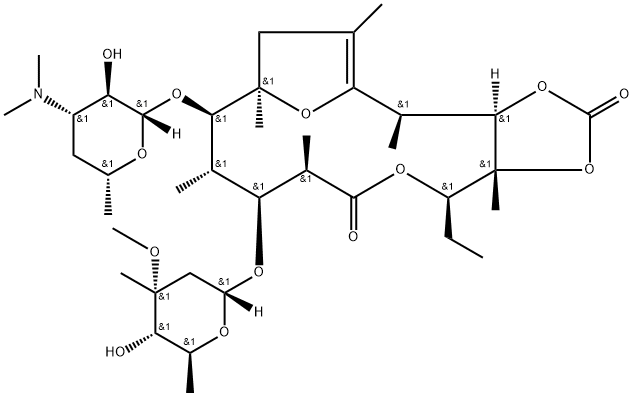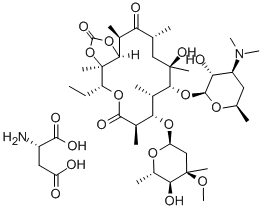Davercin
- CAS NO.:55224-05-0
- Empirical Formula: C38H65NO14
- Molecular Weight: 759.93
- MDL number: MFCD28348360
- SAFETY DATA SHEET (SDS)
- Update Date: 2024-11-19 20:33:22

What is Davercin?
Description
Davercin is a macrolide antibiotic that inhibits bacterial protein synthesis by targeting the 50S ribosomal subunit, blocking the progression of nascent polypeptide chains. It has broad-spectrum activity against various Gram-positive and Gram-negative bacteria (MICs = 0.02-50 μg/ml). Davercin is non-toxic to mice and rats (LD50s = 4.05 and 5.9 g/kg, respectively). Formulations containing davercin have been used to treat a variety of urogenital bacterial infections.
The Uses of Davercin
Davercin (erythromycin A cyclic 11,12-carbonate) is a first generation semi-synthetic erythromycin. Davercin is prepared by coupling the 11- and 12-OH groups to form a cyclic carbonate. This simple modification improves the stability and hydrophobicity of the macrocyclic structure. Davercin shows comparable or better in vitro potency, low host toxicity and improved pharmacokinetics compared with erythromycin.
The Uses of Davercin
Erythromycin Cyclocarbonate is a derivative of Erythromycin (E649950), an antibcterial agent working on the 50S ribosomal subunit.
Definition
ChEBI: Davercin is an aminoglycoside.
What are the applications of Application
Davercin is a high potency semi-synthetic erythromycin
Properties of Davercin
| Melting point: | >135°C (dec.) |
| Boiling point: | 859.8±65.0 °C(Predicted) |
| Density | 1.22±0.1 g/cm3(Predicted) |
| storage temp. | 2-8°C |
| solubility | Chloroform (Slightly), Ethanol (Slightly), Methanol (Slightly) |
| form | Solid |
| pka | 13.49±0.70(Predicted) |
| color | White |
Safety information for Davercin
Computed Descriptors for Davercin
New Products
Tert-butyl bis(2-chloroethyl)carbamate (S)-3-Aminobutanenitrile hydrochloride N-Boc-D-alaninol N-BOC-D/L-ALANINOL N-octanoyl benzotriazole 4-Hydrazinobenzoic acid 3,4-Dibenzyloxybenzaldehyde 1,1’-CARBONYLDIIMIDAZOLE R-2-BENZYLOXY PROPIONIC ACID 1,1’-CARBONYLDI (1,2-4 TRIAZOLE) 4-HYDROXY BENZYL ALCOHOL 3-NITRO-2-METHYL ANILINE (2-Hydroxyphenyl)acetonitrile 4-Bromopyrazole 5-BROMO-2CYANO PYRIDINE 5,6-Dimethoxyindanone 5-broMo-2-chloro-N-cyclopentylpyriMidin-4-aMine 4-methoxy-3,5-dinitropyridine 2-(Cyanocyclohexyl)acetic acid 2-aminopropyl benzoate hydrochloride 1-(4-(aminomethyl)benzyl)urea hydrochloride tert-butyl 4- (ureidomethyl)benzylcarbamate diethyl 2-(2-((tertbutoxycarbonyl)amino) ethyl)malonate Ethyl-2-chloro((4-methoxyphenyl)hydrazono)acetateRelated products of tetrahydrofuran








You may like
-
 873-83-6 6-Aminouracil (or) 4-Amino-2,6- dihydroxypyrimidine, (or) 6-Amino2,4-pyrimidinediol 99%View Details
873-83-6 6-Aminouracil (or) 4-Amino-2,6- dihydroxypyrimidine, (or) 6-Amino2,4-pyrimidinediol 99%View Details
873-83-6 -
 55441-95-7 99%View Details
55441-95-7 99%View Details
55441-95-7 -
 N-Vinylformamide 99%View Details
N-Vinylformamide 99%View Details
13162-05-5 -
 Chloro Uracil 1820-81-1 99%View Details
Chloro Uracil 1820-81-1 99%View Details
1820-81-1 -
 207557-35-5 99%View Details
207557-35-5 99%View Details
207557-35-5 -
 2-ethyl-6-methyl-3-hydroxypyridine succinate 99%View Details
2-ethyl-6-methyl-3-hydroxypyridine succinate 99%View Details
127464-43-1 -
 2-ETHYLPYRIDINE 100-71-0 99%View Details
2-ETHYLPYRIDINE 100-71-0 99%View Details
100-71-0 -
 181228-33-1 (S)-Methyl 3-amino-2-((tert-butoxycarbonyl)amino)propanote Hydrochloride (DAP-OMe. HCl) 99%View Details
181228-33-1 (S)-Methyl 3-amino-2-((tert-butoxycarbonyl)amino)propanote Hydrochloride (DAP-OMe. HCl) 99%View Details
181228-33-1